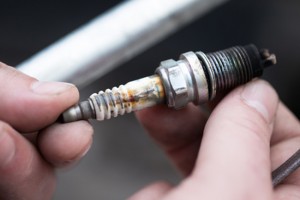 Spark plugs have a major impact on the performance of your car’s engine. Replacing the spark plugs is actually the the most important aspect of a tune-up. While most spark plugs are engineered to last for several thousand miles, they will still need to be replaced at some point. Luckily, changing a set of spark plugs is not an extremely difficult task. Here is a short guide on how to change your vehicle’s spark plugs.
Spark plugs have a major impact on the performance of your car’s engine. Replacing the spark plugs is actually the the most important aspect of a tune-up. While most spark plugs are engineered to last for several thousand miles, they will still need to be replaced at some point. Luckily, changing a set of spark plugs is not an extremely difficult task. Here is a short guide on how to change your vehicle’s spark plugs.
1. Purchase the correct spark plugs
It is critical that you purchase spark plugs that are recommended for your particular vehicle. Purchasing the wrong type of spark plugs can cause a number of problems including a rough idle and poor engine performance. If you are unsure about which spark plugs to choose, contact the dealership or join a forum that caters to your specific type of vehicle. Do not forget to purchase a new set of spark plug wires as well.
2. Gather the essentials
In order to replace the spark plugs, you will need a few items. The list of essentials includes a socket wrench, spark plug socket, gapping tool, socket extension, and anti-seize lubricant. After obtaining the new spark plugs, use the gapping tool to adjust the gap on each spark plug. The gap is the distance between the electrode and the center of the spark plug. The sales representative should be able to tell you the specified spark plug gap for your engine. To prevent the spark plugs from becoming frozen onto the engine block, apply a small amount of anti-seize lubricant around the threads of each spark plug.
3. Begin to replace the spark plugs and wires
Always replace one spark plug at a time. Make sure that the spark plug wire is the exact same length as the wire that you are replacing. Remove the spark plug wire by simply pulling one end from the spark plug and the other end from the distributor cap. Using the socket wrench, carefully remove the old spark plug. Although the new spark plug needs to fit snug, do not make the mistake of over-tightening it. After fitting the new wire onto the spark plug, proceed to the next spark plug.
4. Fire up the engine
After replacing all of the spark plugs and ignition wires, start up the engine. The engine should be running smooth with no signs of trouble. Take the vehicle for a short test drive to verify that everything is functioning properly. If the vehicle fails to crank or idles roughly, recheck all of your work.
If you take your time, you should have no problem changing the spark plugs on your vehicle. Not only will you be saving a lot of extra cash, but you will also gain a sense of pride by performing your own car maintenance.
